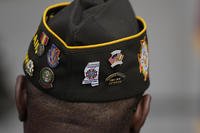The U.S. Army is testing new recoilless rifle technology designed give soldiers shoulder-fired rockets that are lighter and more ergonomic and in future, make them safe to fire in tight urban spaces.
Testers at Aberdeen Proving Ground, Maryland are evaluating upgrades to the M3 recoilless rifle, also known as the Multi-role Anti-armor Anti-personnel Weapon System, or MAAWS. The improvements will make it more ergonomic, six pounds lighter and shorter.
Maneuver officials at Fort Benning, Georgia, are also conducting a live-demo on the new Shoulder Launched Individual Munition, or SLIM, as part of the Army Expeditionary Warrior Experiments, or AEWE, 2017.
SLIM is a new lightweight, disposable shoulder-fired rocket, made by Aerojet Rocketdyne. It weighs 14.9 pounds and is designed to be safely fired from inside enclosures without causing hearing or respiratory system damage, Army officials at the Army’s Maneuver Center of Excellence at Benning maintain.
“At 14.9 pounds, it lightens the soldier load, increases engagement lethality and flexibility by eliminating the need for multiple specialized rocket systems with single purpose warheads,” according to a recent press release from MCOE.
Officials from Benning’s Maneuver Battle Lab will document findings in an initial report on live fire capabilities Nov. 1 and present them in conjunction with the AEWE 2017 Insights Briefing to the public on March 1, 2017.
Findings from the assessment of SLIM and other technologies will inform the material selection process for the Individual Assault Munition capabilities development document and final production decision, Benning officials say.
The Individual Assault Munition, or IAM, is a next-generation, shoulder-launched munition being designed for use by the Objective Force Warrior.
IAM will also contribute to survivability by enabling soldiers to engage targets from protected positions without exposing themselves to enemy fire, Army officials maintain. The new weapon is being designed to combine the best capabilities of the M72 LAW, M136 AT4, M136E1 and M141 BDM and replace them in the Army arsenal.
Meanwhile, Aberdeen test officials are testing improvements to the M3 MAAWS . The 75th Ranger Regiment and other special operations forces began using the recoilless rifle in 1991.
The Army began ordering the M3 for conventional infantry units to use in Afghanistan in 2011. The M3 weighs about 21 pounds and measures 42 inches long. The breech-loading M3 fires an 84mm round that can reach out and hit enemy bunkers and light-armored vehicles up to 1,000 meters away.
Program officials will incorporate modern materials to “achieve input provided by U.S. Special Operations Command and other services' users,” said Renee Bober, Product Manager for the M3E1 at U.S. Army Project Manager Soldier Weapons, in a recent Army press release.
To assist in the project with funding and expertise, the M3E1 team turned to the Army Foreign Comparative Testing Program and began working with the M3’s Swedish manufacturer, Saab Bofors Dynamics, for testing and qualifying its next-generation weapon, known as the M3A1.
Saab unveiled the new M3A1 in 2014. It’s significantly lighter and shorter than the M3 recoilless rifle. It weighs about 15 pounds and measures 39 3/8 inches long.
The Army project team traveled to Sweden so they could observe and validate the vendor's testing instead of duplicating it back in the U.S., said William "Randy" Everett, FCT project manager.
“It was an innovative solution that saved more than $300,000,” he said.
When testing and qualifications are completed in spring 2017, it is scheduled to go into type classification in the fall of 2017, Army officials maintain. After that, the system will be available for procurement to all Department of Defense services.
The upgraded weapon will able to fire the existing suite of MAAWS ammunition, Army officials maintain.
One of the upgrades will include a shot counter. For safety reasons, a weapon should not fire more than its specified limit of rounds.
Right now, soldiers are manually recording the number of rounds fired in a notebook provided with each weapon. The shot counter will help the system last longer because soldiers can keep a more accurate count of how many rounds go through each weapon, Army officials maintain.










